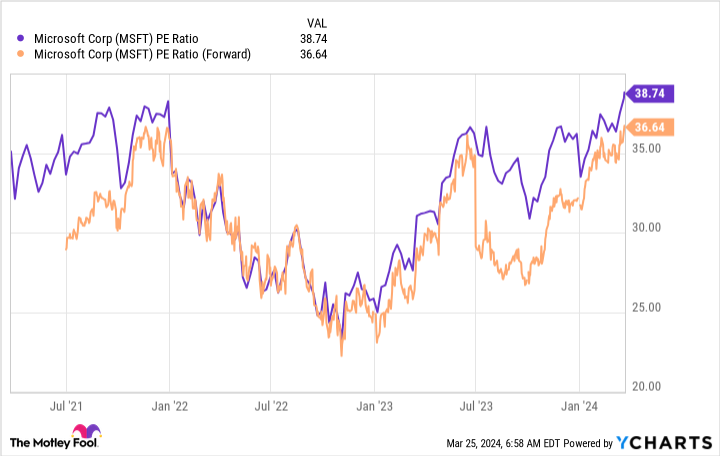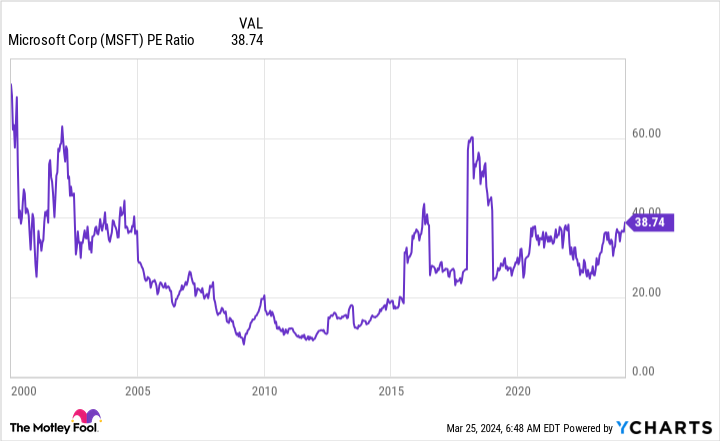The largest company in the world, Microsoft (NASDAQ: MSFT), is also an expensive one, with a trailing price-to-earnings ratio of 39. This could be a massive warning sign for investors.
So, what is this warning sign, and what implications might Microsoft’s performance have it have for the rest of the market? Let’s find out.
Microsoft’s stock has gotten pricey
The flashing warning signal for Microsoft stock is undoubtedly its valuation. With the company trading at nearly 39 times earnings, this is the most expensive Microsoft stock has been (outside of a few years when its earnings were skewed by one-time events) since the early 2000s.
The reason Microsoft has become so expensive is twofold: artificial intelligence (AI) and Microsoft’s execution in that red-hot field. You must give Microsoft props where they’re due; its rollout of AI-powered technologies has been fantastic. Compared to many other companies, Microsoft’s digital assistants have integrated well into its existing products and are available for a reasonable fee (Copilot for Microsoft 365 is $30 per month with an annual commitment).
It also has a partner in OpenAI and its ChatGPT product, which many consider the best generative AI model available, so Microsoft is doing well in the AI game. Furthermore, its cloud computing business, Microsoft Azure, has been growing faster than its top competitors (30% year over year in its latest quarter versus 26% for Google Cloud and 13% for Amazon Web Services). This is a sign that Azure could eventually overtake Amazon as a top player in this space, which would be a huge business boost.
Because Microsoft products have been doing so well, the market has slapped a premium on the stock. The problem is, if you shift your focus from trailing earnings to forward earnings estimates, the stock doesn’t get much cheaper.
Microsoft’s premium valuation could be a problem for more than just itself
Using a forward price-to-earnings (P/E) ratio is a much better way to value a rapidly changing business. It uses analysts’ earnings projections over the next 12 months to price the stock.

With Microsoft’s forward P/E only slightly below its trailing P/E, Wall Street analysts don’t believe Microsoft has a ton of growth left over the next year. For reference, Nvidia, a company posting unbelievable growth numbers, trades at 38 times forward earnings but 80 times trailing earnings.
Microsoft needs to continue posting rapid growth to keep investors happy. For the next quarter, Wall Street analysts project about 6% revenue growth and 6.4% for FY 2024, which ends June 30. They expect another 14% next year.
If Microsoft can’t live up to investor expectations and its stock price drops, the broader market could feel the impact. Because Microsoft is so large, it makes up roughly 7% of the S&P 500. So, if Microsoft’s stock falls to cheaper levels (through a price decrease, not an earnings increase), the index will be heavily swayed in a negative direction and this would have negative effects on many people’s accounts since many of them own the S&P 500.
Additionally, if Microsoft is doing badly, it might be because a broad swath of other companies are struggling. Microsoft provides the basic productivity tools for businesses around the world. If demand for its products start to drop, it would be a sign that its customers (nearly every business in the world) are starting to slow their expansions.This could ignite a larger sell-off.
Either way, I’d be a bit worried if I were a Microsoft shareholder. The stock is likely overvalued, but the effects of it becoming cheaper could harm the greater market. Wall Street analysts don’t expect its 18% revenue growth rate to continue, although it’s hard to predict the future with game-changing technologies like AI. The market is valuing Microsoft like it will have massive AI demand for a while, and any slip-up could be an issue.
Microsoft could continue to do well, grow at a market pace (or slightly higher), and still be far too expensive. With other stocks growing faster than Microsoft (like Nvidia), there may be better places to look to deploy your money.
Microsoft will likely be a successful company, but with such high expectations baked into the stock as seen in its valuation, it could be a difficult investment to make money with over the next three to five years.
Where to invest $1,000 right now
When our analyst team has a stock tip, it can pay to listen. After all, the newsletter they have run for two decades, Motley Fool Stock Advisor, has more than tripled the market.*
They just revealed what they believe are the 10 best stocks for investors to buy right now… and Microsoft made the list — but there are 9 other stocks you may be overlooking.
See the 10 stocks
*Stock Advisor returns as of March 25, 2024
Keithen Drury has no position in any of the stocks mentioned. The Motley Fool has positions in and recommends Microsoft. The Motley Fool recommends the following options: long January 2026 $395 calls on Microsoft and short January 2026 $405 calls on Microsoft. The Motley Fool has a disclosure policy.
1 Flashing Warning Signal Microsoft Investors Must Be Aware Of was originally published by The Motley Fool
Credit: Source link




